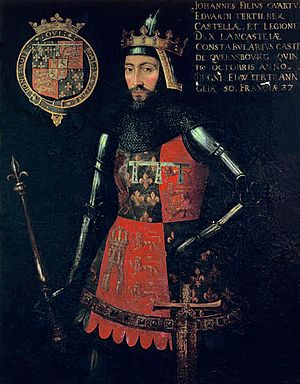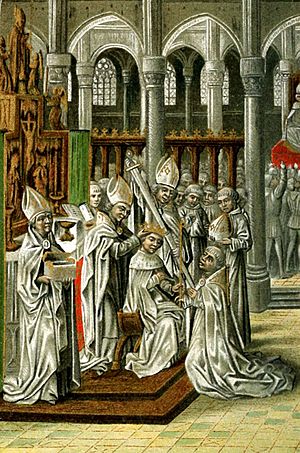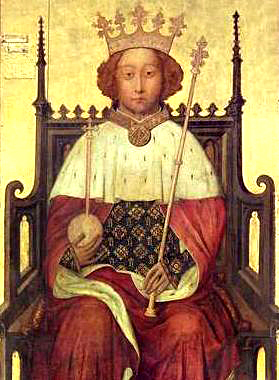John Cornwall (c.1366-1414) facts for kids
Quick facts for kids
Sir
John Cornwall
|
|
|---|---|
| Member of the English Parliament for Shropshire |
|
| In office 30 September 1402 – 25 November 1402 Serving with Sir Adam Peshale
|
|
| Preceded by | Sir Hugh Cheyne, John Burley |
| Succeeded by | John Burley, George Hawkestone |
| In office 20 October 1407 – 12 December 1407 Serving with David Holbache
|
|
| Preceded by | David Holbache, Thomas Whitton |
| Succeeded by | John Burley, David Holbache |
| Personal details | |
| Born | c. 1366 |
| Died | 3 July 1414 (aged 47–48) |
| Nationality | English |
| Spouses | Joan Wasteneys of Eastham Maud |
| Children | Elizabeth and Margaret |
| Occupation | Landowner, soldier. |
Sir John Cornwall (born around 1366, died 1414) was an important English soldier, politician, and landowner. He fought in the Hundred Years' War and helped stop the Glyndŵr Rising in Wales.
John Cornwall was a respected figure. He was connected to the royal family through his ancestors. Because he was part of the Duke of Lancaster's group of supporters, he received special favors from King Henry IV. He was also chosen twice to represent Shropshire in the English Parliament.
Contents
Family Background and Royal Connections
John Cornwall was the son of Brian de Cornwall, who passed away in 1391. His family came from Kinlet, a place in Shropshire.
John's grandfather, Edmund de Cornwall, was the eldest son of Sir Richard of Cornwall. Sir Richard was an illegitimate son of Richard, 1st Earl of Cornwall. This Richard was a very wealthy brother of King Henry III. He was even chosen to be the King of the Romans for a time. This means that John Cornwall's family could truly say they were related to King John himself!
The Cornwall family got their main estate, Kinlet, by marriage. Edmund de Cornwall married Elizabeth, one of the daughters of Brian Brampton. Brian Brampton had owned many estates in Shropshire and Herefordshire. Edmund was called the "king's yeoman and kinsman" by King Edward I.
John's father, Brian, fought in France in 1346. He was part of the army led by John, 2nd Baron Strange of Blackmere. Brian fought bravely in the famous Battle of Crécy and during the Siege of Calais. Because of his service, he received special tax breaks. Brian married Maud Le Strange, and John was their oldest son who survived. John was born around 1366. He had three brothers who all died young, and a sister named Isabel.
Becoming a Landowner
When John's father, Brian Cornwall, died in 1391, John inherited his lands. Records show that John was about 24 years old at the time. He inherited estates in Oxfordshire, including the manor of Asthall. This property had been given to his ancestor, Richard of Cornwall, by King Henry III back in 1227. John also inherited Kinlet in Shropshire and a part of Ashton in Herefordshire.
John's mother, Maud, kept a large share of the estates' income during her lifetime. This meant John did not become extremely wealthy right away. Kinlet, his main home in Shropshire, did not make much money. This was common in the 14th century. Many areas faced hard times due to farming problems and the Black Death plague. It was often difficult to find people to rent land or work on farms.
John also gained control of the manor of Eastham, Worcestershire when he married Joan Wasteneys. He became the patron of the church there, which meant he could choose the priest. The Eastham manor was not very valuable, but it added to his landholdings.
A Career in Politics and the Military
Serving the King
In 1395, John Cornwall officially joined the group of supporters of John of Gaunt, the powerful Duke of Lancaster. This was during a time of peace in the Hundred Years' War with France. John promised to serve the Duke in both peace and war for the rest of his life. In return, he received a yearly payment. This payment increased when he became a knight.
Because he was part of the Duke of Lancaster's group, John Cornwall gained favor when Henry IV became king in 1399. He was knighted and immediately made Sheriff of Shropshire. His yearly payment was also confirmed by the new king.
Fighting in the Welsh Rebellion
The Glyndŵr Rising, a rebellion led by Owain Glyndŵr in Wales, became a major part of John Cornwall's career. In 1403, King Henry IV ordered him to protect and hold Manorbier Castle in Wales.
Later, in 1405, John Cornwall was given an important job. He, along with John Burley and Thomas Young, was told to oversee the gathering of troops in Shropshire and Cheshire. This was because Prince Henry (who would later become king) needed many soldiers for a military expedition in North Wales.
John Cornwall worked closely with the Earl of Arundel, who was a very powerful landowner in Shropshire. The Earl and the King relied on John Cornwall for his service in Wales. In 1405, John Cornwall and others were tasked with raising more troops for the Earl to protect castles in North Wales and Shropshire. They were also asked to find people in Shropshire who were secretly helping the Welsh rebels.
Serving in Parliament
John Cornwall was chosen to be a Member of Parliament for Shropshire twice. His first term was in 1402. His second term was in 1407, when he served alongside David Holbache, a lawyer who worked closely with the Earl of Arundel.
Keeper of Morfe and Shirlett Forests
John Cornwall was appointed as the keeper of Morfe and Shirlett, which were royal forests in Shropshire. This was a valuable position, and he received wages and fees for it. He was trusted by the king at this time. He also helped with legal tasks, like investigating a murder and making arrests for the king.
However, John Cornwall sometimes caused problems in his role. He was accused of interfering with the rights of other landowners and their tenants to use the common lands for grazing animals. Even powerful figures like Lord Bergavenny and the Dean of the royal chapel at Bridgnorth complained about him. Because of these complaints, King Henry IV asked John Cornwall to step down from his position. In 1413, a new keeper was appointed in his place.
Family Life and Legacy
Sir John Cornwall was married twice. His first wife was Joan Wasteneys. She was the daughter of Sir William Wasteneys of Eastham. John and Joan had two daughters, Elizabeth and Margaret.
After Joan passed away, John married a second wife named Maud by 1397.
When Sir John Cornwall died in 1414, his daughter Elizabeth became his heir. She was about 24 years old at the time. Elizabeth had married William Lichfield, who became a wealthy man through his marriage and inheritance.
Images for kids
-
Manorbier Castle, Pembrokeshire, viewed from the south west.
See also







